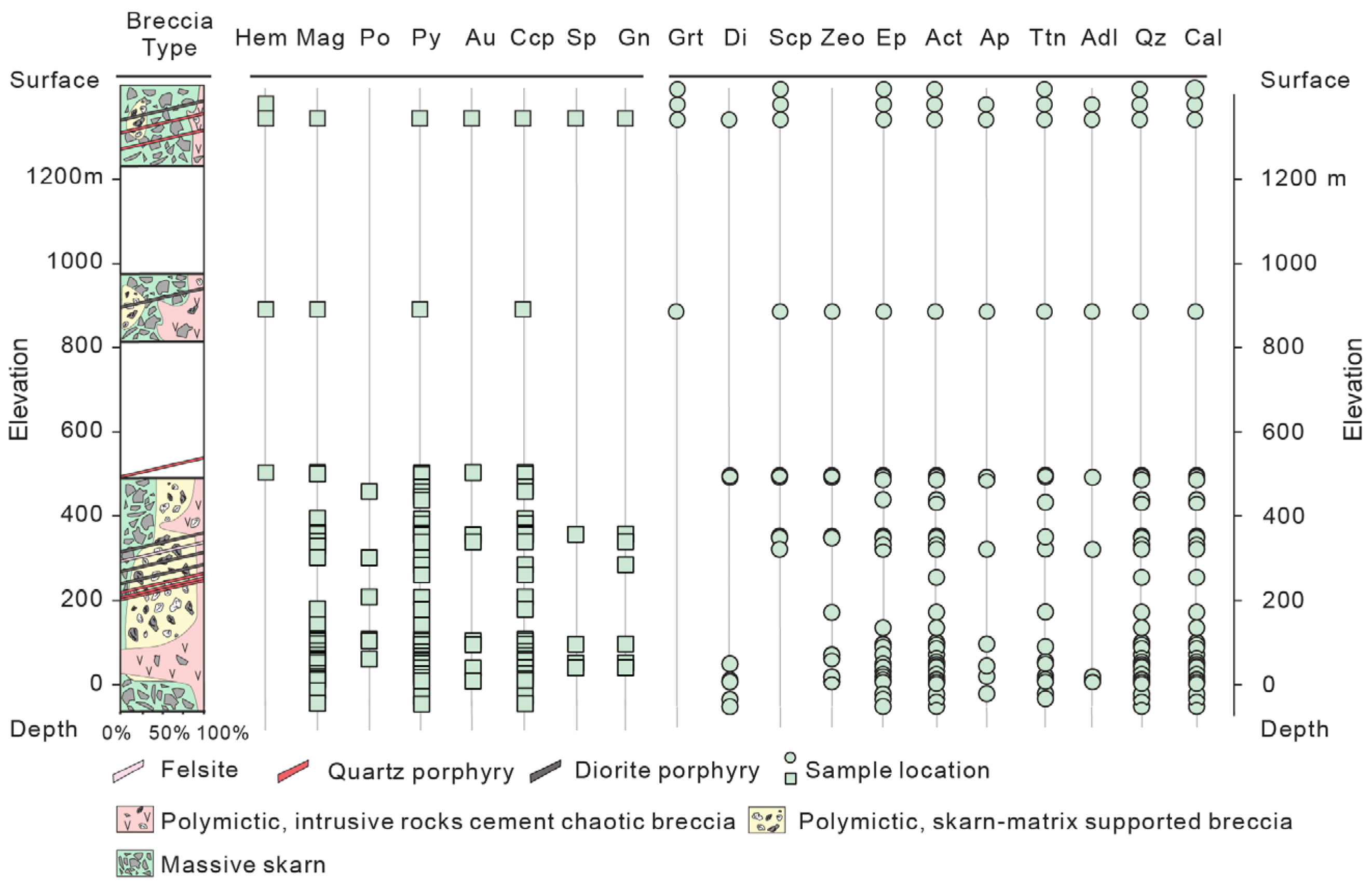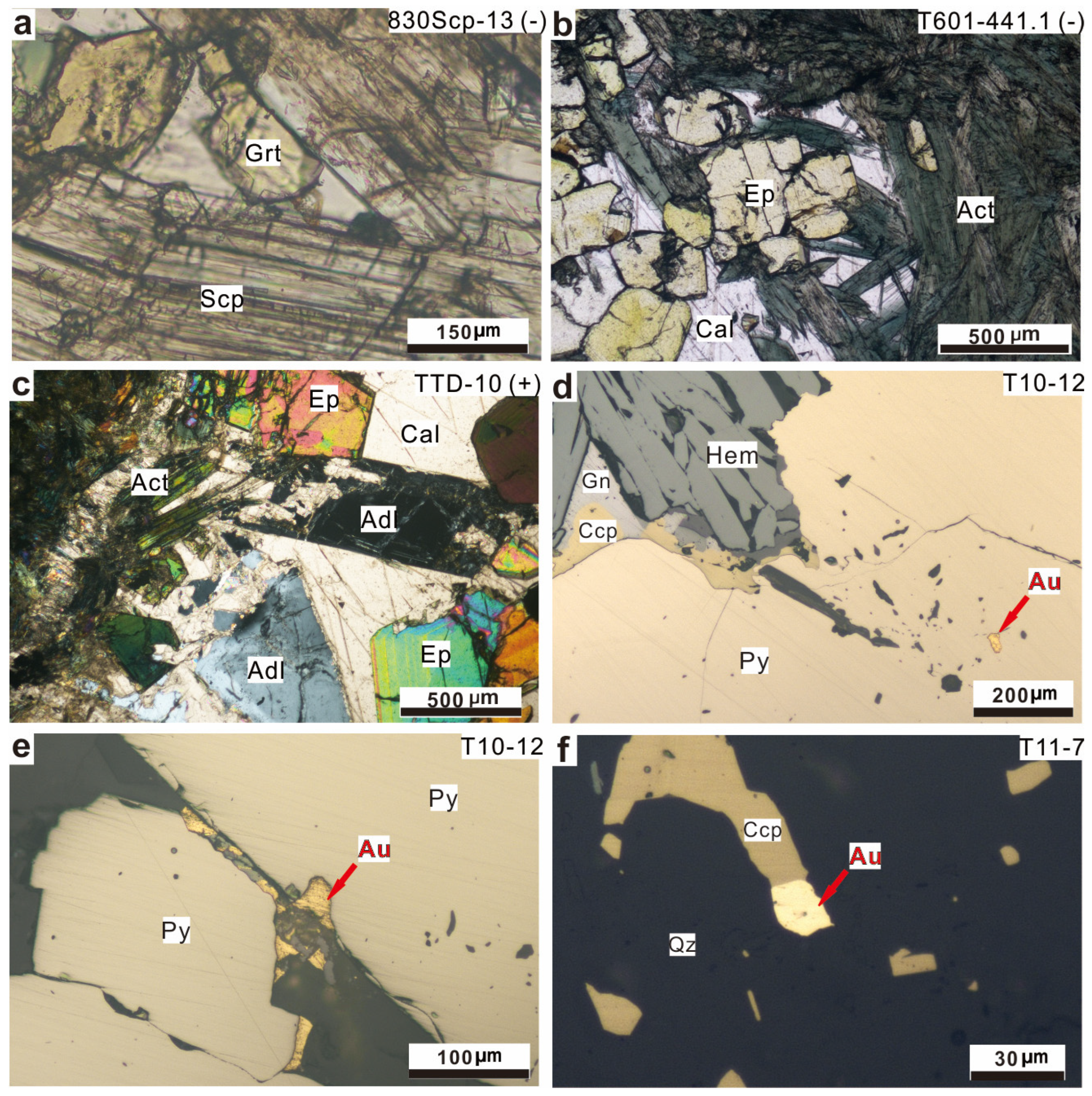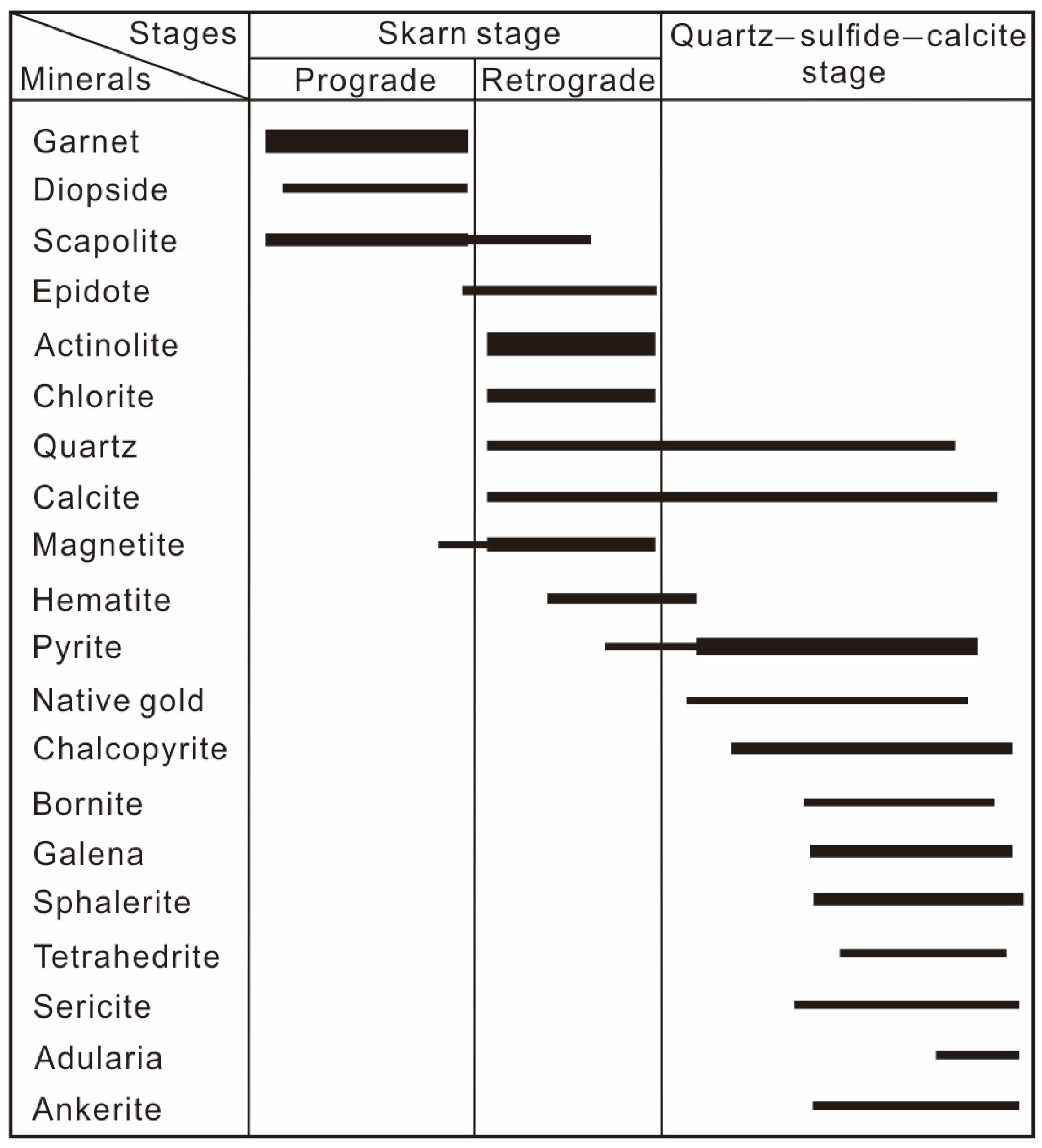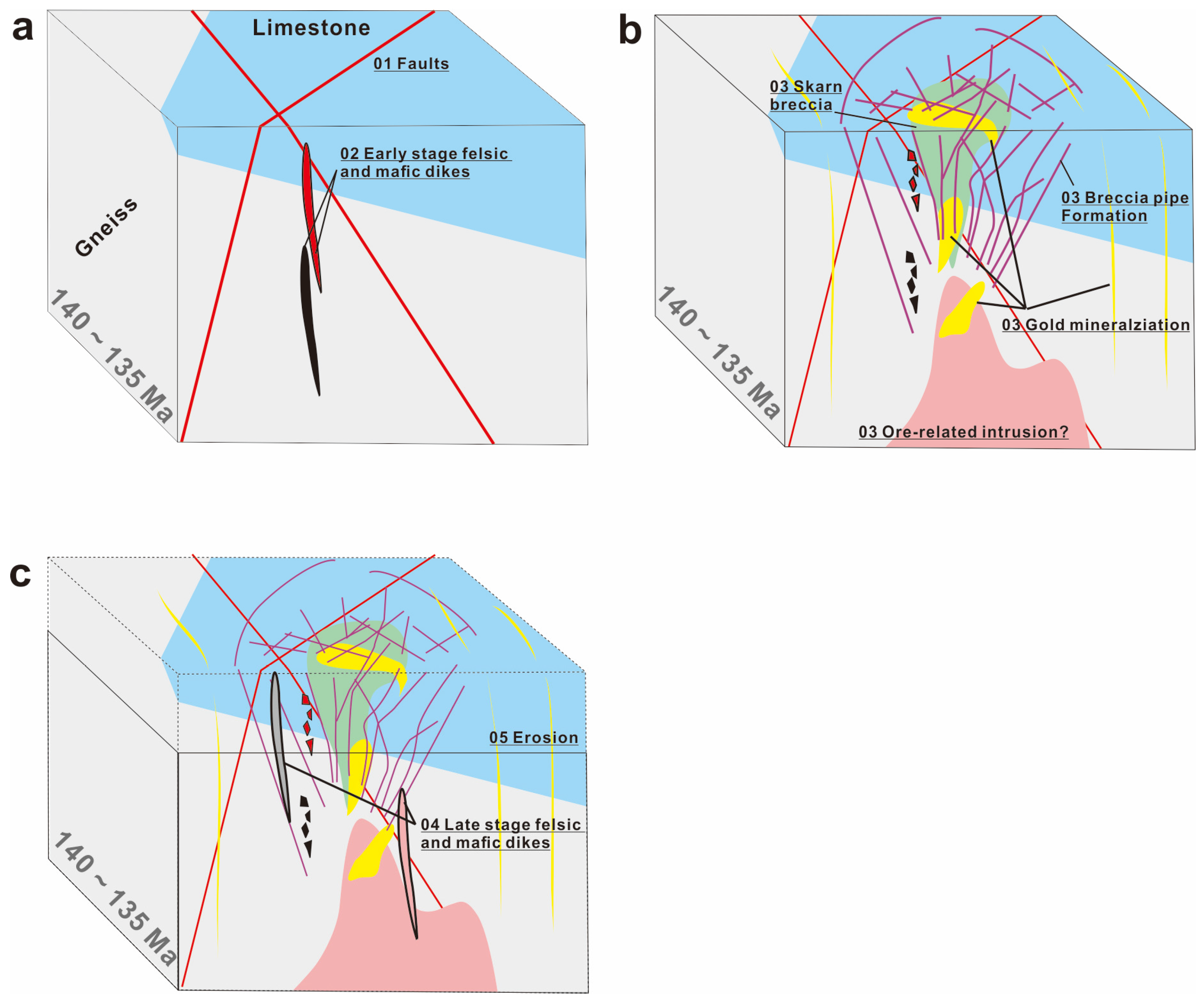Geology and Geochronology of Magmatic–Hydrothermal Breccia Pipes in the Yixingzhai Gold Deposit: Implications for Ore Genesis and Regional Exploration
Abstract
1. Introduction
2. Geological Background
3. Sample and Methods
3.1. Adularia 40Ar/39Ar Dating
3.2. In Situ Sulfur Isotope Analysis
4. Results
4.1. Breccia Facies and Intrusive Sequences
4.2. Mineralization of and Alteration in Tietangdong Breccia Pipe
4.3. 40Ar/39Ar Dating of Adularia
4.4. In Situ Sulfur Isotopes of Pyrite
5. Discussion
5.1. Discrimination and Genesis of Breccia Facies
5.2. The Age of Breccia-Hosted Au Mineralization at Tietangdong
5.3. The Source of Breccia-Hosted Au Mineralization at Tietangdong
5.4. Genetic Model and Exploration Implications
6. Conclusions
Supplementary Materials
Author Contributions
Funding
Data Availability Statement
Acknowledgments
Conflicts of Interest
References
- Frimmel, H.E. Earth’s Continental Crustal Gold Endowment. Earth Planet. Sci. Lett. 2008, 267, 45–55. [Google Scholar] [CrossRef]
- Ulrich, T.; Günther, D.; Heinrich, C.A. Gold Concentrations of Magmatic Brines and the Metal Budget of Porphyry Copper Deposits. Nature 1999, 399, 676–679. [Google Scholar] [CrossRef]
- Sillitoe, R.H. Porphyry Copper Systems. Econ. Geol. 2010, 105, 3–41. [Google Scholar] [CrossRef]
- Sillitoe, R.H. Ore-Related Breccias in Volcanoplutonic Arcs. Econ. Geol. 1985, 80, 1467–1514. [Google Scholar] [CrossRef]
- Chen, J.; Cooke, D.R.; Piquer, J.; Selley, D.; Zhang, L.; White, N.C. Hydrothermal Alteration, Mineralization, and Structural Geology of the Zijinshan High-Sulfidation Au-Cu Deposit, Fujian Province, Southeast China. Econ. Geol. 2019, 114, 639–666. [Google Scholar] [CrossRef]
- Wang, B.; Zhou, T.-F.; Fan, Y.; Chen, J.; Liu, Y.-N.; Chen, Y. Breccia, Hydrothermal Alteration and Structural Geology of the Huangtun Porphyry Au-Cu Deposit in the Middle-Lower Yangtze Metallogenic Belt, Eastern China. Ore Geol. Rev. 2020, 120, 103414. [Google Scholar] [CrossRef]
- Sun, Y.; Wang, X.; Zhang, Y.; Li, D.; Shan, W.; Geng, K.; Wei, P.; Liu, Q.; Xie, W.; Chi, N. Cu and S Isotopes of the Main Sulfides and Indicative Significance in the Qibaoshan Cu-Au Polymetallic Ore District, Wulian County, Shandong Province, North China Craton. Minerals 2023, 13, 723. [Google Scholar] [CrossRef]
- Jensen, E.P. Magmatic and Hydrothermal Evolution of the Cripple Creek Gold Deposit, Colorado, and Comparisons with Regional and Global Magmatic-Hydrothermal Systems Associated with Alkaline Magmatism. Ph.D. Thesis, University of Arizona, Tucson, AZ, USA, 2003. [Google Scholar]
- Thompson, T.B.; Trippel, A.D.; Dwelley, P.C. Mineralized Veins and Breccias of the Cripple Creek District, Colorado. Econ. Geol. 1985, 80, 1669–1688. [Google Scholar] [CrossRef]
- Pass, H.E. Breccia-Hosted Chemical and Mineralogical Zonation Patterns of the Northeast Zone, Mt. Polley Cu-Ag-Au Alkalic Porphyry Deposit, British Columbia, Canada. Ph.D. Thesis, University of Tasmania, Hobart, Australia, 2010. [Google Scholar]
- Davies, A.G.S. Geology and Genesis of the Kelian Gold Deposit, East Kalimantan, Indonesia. Ph.D. Thesis, University of Tasmania, Hobart, Australia, 2002. [Google Scholar]
- Blackwell, J.L. Characteristics and Origins of Breccias in a Volcanic Hosted Alkalic Epithermal Gold Deposit, Ladolam, Lihir Island, Papua New Guinea. Ph.D. Thesis, University of Tasmania, Hobart, Australia, 2010. [Google Scholar]
- Sillitoe, R.H. Intrusion-Related Gold Deposits. In Gold Metallogeny and Exploration; Springer: Dordrecht, The Netherlands, 1991; pp. 165–209. [Google Scholar]
- Jing, S.-H. Study of the Geology and Mineralization Rules of the Yixingzhai Gold Deposit, Fanshi County, Shanxi Province; Unpublished Geological Report; 211 Geological Team of Shanxi Bureau of Geology and Mineral Resources: Taiyuan, China, 1985. [Google Scholar]
- Li, S.; Ma, X. Crypto Explosive Rock and Its Ore-Forming Sense to Gold-Silver Deposit in the Northeastern Shanxi Province, China. Contrib. Geol. Miner. Resour. Res. 1999, 14, 8–14. [Google Scholar]
- Zhang, J.-Q.; Li, S.-R.; Santosh, M.; Li, Q.; Niu, S.-D.; Lu, J.; Yan, L.-N. The Diaoquan Ag-Cu Polymetallic Skarn Mineralization in Central North China Craton: Timing, Source and Genetic Model. Ore Geol. Rev. 2019, 104, 745–764. [Google Scholar] [CrossRef]
- Zhang, J.-Q.; Li, S.-R.; Santosh, M.; Niu, S.-D.; Li, Q.; Lu, J. The Magmatic–Hydrothermal Mineralization Systems of the Yixingzhai and Xinzhuang Gold Deposits in the Central North China Craton. Ore Geol. Rev. 2017, 88, 416–435. [Google Scholar] [CrossRef]
- Zhang, J.-Q.; Li, S.-R.; Santosh, M.; Li, Q.; Niu, S.-D.; Li, Z.-D.; Zhang, X.-G.; Jia, L.-B. Timing and Origin of Mesozoic Magmatism and Metallogeny in the Wutai-Hengshan Region: Implications for Destruction of the North China Craton. J. Asian Earth Sci. 2015, 113, 677–694. [Google Scholar] [CrossRef]
- Liu, T.; Xiong, S.-F.; Jiang, S.-Y.; Li, H.-L.; Chen, Q.-Z.; Jiang, H. Genesis of the Zhijiadi Ag-Pb-Zn Deposit, Central North China Craton: Constraints from Fluid Inclusions and Stable Isotope Data. Geofluids 2017, 2017, 4153618. [Google Scholar] [CrossRef]
- Zhang, L.-Z. Element Geochemistry and Age of the Altered-Porphyry Gold Mineralization in Yixingzhai Gold Deposit, Fanshi City, Shanxi Province. Geol. Miner. Resour. South China 2018, 34, 134–141. [Google Scholar] [CrossRef]
- Zhang, L.-Z.; Chen, L.; Wang, G.; Deng, X.-D.; Li, J.-W. Garnet U⁃Pb Dating Constraints on the Timing of Breccia Pipes Formation and Genesis of Gold Mineralization in Yixingzhai Gold Deposit, Shanxi Province. Eart. Scie. 2020, 45, 108. [Google Scholar] [CrossRef]
- Zhang, J.-Q.; Li, S.-R.; Santosh, M.; Luo, J.-Y.; Li, C.-L.; Song, J.-Y.; Lu, J.; Liang, X. The Genesis and Gold Mineralization of the Crypto-Explosive Breccia Pipe in the Yixingzhai Gold Region, Central North China Craton. Geol. J. 2020, 55, 5664–5680. [Google Scholar] [CrossRef]
- Shao, Y.; Zhang, Y.; Zhang, J.; Ding, Z.; Chen, X.; Liu, Z. Formation Mechanism of Breccia Pipe Type in Yixingzhai Gold Deposit. J. Cent. South Univ. Technol. 2008, 15, 89–94. [Google Scholar] [CrossRef]
- Zhao, G.; Sun, M.; Wilde, S.A.; Sanzhong, L. Late Archean to Paleoproterozoic Evolution of the North China Craton: Key Issues Revisited. Precambrian Res. 2005, 136, 177–202. [Google Scholar] [CrossRef]
- Tang, L.; Santosh, M. Neoarchean-Paleoproterozoic Terrane Assembly and Wilson Cycle in the North China Craton: An Overview from the Central Segment of the Trans-North China Orogen. Earth-Sci. Rev. 2018, 182, 1–27. [Google Scholar] [CrossRef]
- Tian, Y.Q.; Yu, K.R.; Wang, A.J.; Xu, W.L. Geodynamic of Veined Gold Deposit Mineralization of Wutaishan-Hengshan Area. J. Geol. Miner. Resour. North China 1998, 13, 301–456. [Google Scholar]
- Chang, J.; Audétat, A.; Li, J.-W. Tectono-Magmatic Controls on Decratonic Gold Deposits. Contrib. Mineral. Petrol. 2021, 176, 69. [Google Scholar] [CrossRef]
- Deng, X.-D.; Li, J.-W.; Wen, G. U-Pb Geochronology of Hydrothermal Zircons from the Early Cretaceous Iron Skarn Deposits in the Handan-Xingtai District, North China Craton. Econ. Geol. 2015, 110, 2159–2180. [Google Scholar] [CrossRef]
- Chang, Z.-G.; Dong, G.-C.; Somarin, A.K. U-Pb Dating and Trace Element Composition of Zircons from the Gujiao Ore-Bearing Intrusion, Shanxi, China: Implications for Timing and Mineralization of the Guojialiang Iron Skarn Deposit. Minerals 2020, 10, 316. [Google Scholar] [CrossRef]
- Li, S.-R.; Santosh, M.; Zhang, H.-F.; Luo, J.-Y.; Zhang, J.-Q.; Li, C.-L.; Song, J.-Y.; Zhang, X.-B. Metallogeny in Response to Lithospheric Thinning and Craton Destruction: Geochemistry and U–Pb Zircon Chronology of the Yixingzhai Gold Deposit, Central North China Craton. Ore Geol. Rev. 2014, 56, 457–471. [Google Scholar] [CrossRef]
- Deng, X.-R.; Deng, X.-D.; Zhang, L.-Z.; Gao, W.-S.; Li, Y.-X.; Yang, H.-P.; Li, Z.-B. U-Pb Geochronology and Trace Element Analysis of Titanite from the Diaoquan Porphyry-Skarn Polymetallic Deposit, North China: Implication for Cu-Ag-Mo Mineralization. Earth Sci. 2023, 48, 3327–3341. [Google Scholar] [CrossRef]
- Li, J.; Li, N.; Wang, M.; Song, Y.; Tang, Z.; Zhang, P.; Wang, G.; Zhang, L. Formation of the Miaoan Au-Polymetallic Deposit in the Northern Taihang Mountain, North China Craton: Ore Geology, Geochronological and Geochemical Perspectives. Minerals 2022, 12, 1144. [Google Scholar] [CrossRef]
- Wang, S. Age Determinations of 40Ar-40K, 40Ar-39Ar and Radiogenic 40Ar Released Characteristics on K-Ar Geostandards of China. Chin. J. Geol. 1983, 18, 315–323. [Google Scholar]
- Bai, X.-J.; Qiu, H.-N.; Liu, W.-G.; Mei, L.-F. Automatic 40Ar/39Ar Dating Techniques Using Multicollector ARGUS VI Noble Gas Mass Spectrometer with Self-Made Peripheral Apparatus. J. Earth Sci. 2018, 29, 408–415. [Google Scholar] [CrossRef]
- Koppers, A.A.P. ArArCALC—Software for 40Ar/39Ar Age Calculations. Comput. Geosci. 2002, 28, 605–619. [Google Scholar] [CrossRef]
- Steiger, R.H.; Jäger, E. Subcommission on Geochronology: Convention on the Use of Decay Constants in Geo- and Cosmochronology. Earth Planet. Sci. Lett. 1977, 36, 359–362. [Google Scholar] [CrossRef]
- Fu, J.; Hu, Z.; Li, J.; Yang, L.; Zhang, W.; Liu, Y.; Li, Q.; Zong, K.; Hu, S. Accurate Determination of Sulfur Isotopes (δ33S and δ34S) in Sulfides and Elemental Sulfur by Femtosecond Laser Ablation MC-ICP-MS with Non-Matrix Matched Calibration. J. Anal. At. Spectrom. 2017, 32, 2341–2351. [Google Scholar] [CrossRef]
- Li, R.; Xia, X.; Yang, S.; Chen, H.; Yang, Q. Off-Mount Calibration and One New Potential Pyrrhotite Reference Material for Sulfur Isotope Measurement by Secondary Ion Mass Spectrometry. Geostand. Geoanal. Res. 2019, 43, 177–187. [Google Scholar] [CrossRef]
- Zhang, W.; Hu, Z.; Liu, Y. Iso-Compass: New Freeware Software for Isotopic Data Reduction of LA-MC-ICP-MS. J. Anal. At. Spectrom. 2020, 35, 1087–1096. [Google Scholar] [CrossRef]
- Turner, G.; Cadogan, P.H. Possible Effects of 39Ar Recoil in 40Ar-39Ar Dating. In Proceedings of the Fifth Lunar Science Conference, Houston, TX, USA, 18–22 March 1974; Volume 2, pp. 1601–1615. [Google Scholar]
- Hoefs, J. Stable Isotope Geochemistry; Springer Textbooks in Earth Sciences, Geography and Environment; Springer International Publishing: Cham, Switzerland, 2021; ISBN 978-3-030-77691-6. [Google Scholar]
- Luo, G.; Ono, S.; Huang, J.; Algeo, T.J.; Li, C.; Zhou, L.; Robinson, A.; Lyons, T.W.; Xie, S. Decline in Oceanic Sulfate Levels during the Early Mesoproterozoic. Precambrian Res. 2015, 258, 36–47. [Google Scholar] [CrossRef]
- Meinert, L.D.; Dipple, G.M.; Nicolescu, S. World Skarn Deposits. In One Hundredth Anniversary Volume; Society of Economic Geologists: Littleton, CO, USA, 2005; ISBN 978-1-887483-01-8. [Google Scholar]
- Dong, G.; Morrison, G.W. Adularia in Epithermal Veins, Queensland: Morphology, Structural State and Origin. Miner. Depos. 1995, 30, 11–19. [Google Scholar] [CrossRef]
- Chiaradia, M.; Schaltegger, U.; Spikings, R.; Wotzlaw, J.-F.; Ovtcharova, M. How Accurately Can We Date the Duration of Magmatic-Hydrothermal Events in Porphyry Systems?—An Invited Paper. Econ. Geol. 2013, 108, 565–584. [Google Scholar] [CrossRef]
- Horstwood, M.S.A.; Košler, J.; Gehrels, G.; Jackson, S.E.; McLean, N.M.; Paton, C.; Pearson, N.J.; Sircombe, K.; Sylvester, P.; Vermeesch, P.; et al. Community-Derived Standards for LA-ICP-MS U-(Th-)Pb Geochronology—Uncertainty Propagation, Age Interpretation and Data Reporting. Geostand. Geoanal. Res. 2016, 40, 311–332. [Google Scholar] [CrossRef]
- Chelle-Michou, C.; Schaltegger, U. U-Pb Dating of Mineral Deposits: From Age Constraints to Ore-Forming Processes. In Isotopes in Economic Geology, Metallogenesis and Exploration; Huston, D., Gutzmer, J., Eds.; Mineral Resource Reviews; Springer International Publishing: Cham, Switzerland, 2023; pp. 37–87. ISBN 978-3-031-27896-9. [Google Scholar]
- Ohmoto, H. Systematics of Sulfur and Carbon Isotopes in Hydrothermal Ore Deposits. Econ. Geol. 1972, 67, 551–578. [Google Scholar] [CrossRef]
- Zhu, R.; Fan, H.; Li, J.; Meng, Q.; Li, S.; Zeng, Q. Decratonic Gold Deposits. Sci. China Earth Sci. 2015, 58, 1523–1537. [Google Scholar] [CrossRef]
- Phillips, G.N.; Evans, K.A. Role of CO2 in the Formation of Gold Deposits. Nature 2004, 429, 860–863. [Google Scholar] [CrossRef]
- Ohmoto, H.; Rye, R.O.; Barnes, H.L. Geochemistry of Hydrothermal Ore Deposits; John Willey &. Sons Inc.: Hoboken, NJ, USA, 1979; Volume 517, p. 612. [Google Scholar]
- Hutchison, W.; Finch, A.A.; Boyce, A.J. The Sulfur Isotope Evolution of Magmatic-Hydrothermal Fluids: Insights into Ore-Forming Processes. Geochim. Cosmochim. Acta 2020, 288, 176–198. [Google Scholar] [CrossRef]








| Breccia Facies | Interpretation | Component | Internal Organization and Mineralization | Spatial Distribution | ||||
|---|---|---|---|---|---|---|---|---|
| Clast | Matrix | Cement | Open Space | |||||
| Skarn breccia (SKB) | Massive skarn (MSK) | Magmatic–hydrothermal breccia | Aggregates of massive prograde and retrograde skarn minerals (Grt, Scp, Di, Act, Ep, Qz, Chl, and Cal) with fine to medium grain sizes (2–64 mm), commonly lacking definitive boundaries between the clasts and the cement; ore minerals include Mag, Hem, Py, Ccp, Sp, Gn, and Au | <5 vol.% vugs | Massive skarn ores, mainly bearing low to high grades of gold and iron | Mainly distributed at the top of the Tietangdong breccia pipe | ||
| Polymictic, skarn matrix-supported breccia (SMB) | Magmatic–hydrothermal breccia | 5–70 vol.%; generally rounded to sub-rounded; polymictic clasts, including felsite, gneiss, amphibolite, and a few skarn carbonate clasts; the clasts measure 5–30 mm, with blocks measuring up to 20 cm occasionally | 30–95 vol.%; skarn minerals (Scp, Act, Ep, Py, Ccp) that are predominantly 1–2 mm | – | <5 vol.% vugs | Chaotic; mainly matrix supported; no high grade of gold | ||
| Polymictic, intrusive rock cement chaotic breccia (PICB) | Intrusive breccia | 10–75 vol.%; rounded to sub-rounded; polymictic clasts, including partly skarn carbonate clasts, gneiss, amphibolite, and some felsite clasts; the clasts measure 5–60 mm | – | 15–90 vol.%; igneous rocks (felsite, granite porphyry, and diorite porphyry) | – | Chaotic; cement supported to clast supported; rarely mineralized | Mainly distributed at the bottom of the Tietangdong breccia pipe | |
| Sample no. | Elevation (m) | Minerals | δ34S (‰) | 2SD (‰) | Secondary Standard | δ34S (‰) | 2SD (‰) |
|---|---|---|---|---|---|---|---|
| T601-494.7-01 | 15 | Pyrite | 2.48 | 0.10 | YP136 | 1.33 | 0.12 |
| T601-494.7-02 | 15 | Pyrite | 2.69 | 0.10 | YP136 | 1.56 | 0.16 |
| T601-494.7-03 | 15 | Pyrite | 2.73 | 0.11 | YP136 | 1.44 | 0.16 |
| T601-251.6-01 | 258 | Pyrite | 2.63 | 0.10 | YP136 | 1.49 | 0.09 |
| T601-251.6-02 | 258 | Pyrite | 2.03 | 0.10 | YP136 | 1.51 | 0.11 |
| T601-251.6-03 | 258 | Pyrite | 2.16 | 0.08 | YP136 | 1.39 | 0.18 |
| T11-16-2-01 | 1380 | Pyrite | 6.59 | 0.11 | YP136 | 1.27 | 0.12 |
| T11-16-2-02 | 1380 | Pyrite | 6.56 | 0.11 | YP136 | 1.49 | 0.15 |
| T11-16-2-03 | 1380 | Pyrite | 5.29 | 0.11 | YP136 | 1.41 | 0.14 |
| 830-9-01 | 830 | Pyrite | 3.98 | 0.13 | YP136 | 1.55 | 0.12 |
| 830-9-02 | 830 | Pyrite | 4.13 | 0.12 | |||
| 830-9-03 | 830 | Pyrite | 9.01 | 0.14 | |||
| 830-9-04 | 830 | Pyrite | 4.94 | 0.16 | |||
| T510-3-2-01 | 510 | Pyrite | 3.67 | 0.10 | |||
| T510-3-2-02 | 510 | Pyrite | 4.22 | 0.11 | |||
| T510-3-2-03 | 510 | Pyrite | 2.10 | 0.10 |
Disclaimer/Publisher’s Note: The statements, opinions and data contained in all publications are solely those of the individual author(s) and contributor(s) and not of MDPI and/or the editor(s). MDPI and/or the editor(s) disclaim responsibility for any injury to people or property resulting from any ideas, methods, instructions or products referred to in the content. |
© 2024 by the authors. Licensee MDPI, Basel, Switzerland. This article is an open access article distributed under the terms and conditions of the Creative Commons Attribution (CC BY) license (https://creativecommons.org/licenses/by/4.0/).
Share and Cite
Zhang, L.-Z.; Gao, W.-S.; Deng, X.-D. Geology and Geochronology of Magmatic–Hydrothermal Breccia Pipes in the Yixingzhai Gold Deposit: Implications for Ore Genesis and Regional Exploration. Minerals 2024, 14, 496. https://doi.org/10.3390/min14050496
Zhang L-Z, Gao W-S, Deng X-D. Geology and Geochronology of Magmatic–Hydrothermal Breccia Pipes in the Yixingzhai Gold Deposit: Implications for Ore Genesis and Regional Exploration. Minerals. 2024; 14(5):496. https://doi.org/10.3390/min14050496
Chicago/Turabian StyleZhang, Li-Zhong, Wen-Sheng Gao, and Xiao-Dong Deng. 2024. "Geology and Geochronology of Magmatic–Hydrothermal Breccia Pipes in the Yixingzhai Gold Deposit: Implications for Ore Genesis and Regional Exploration" Minerals 14, no. 5: 496. https://doi.org/10.3390/min14050496
APA StyleZhang, L.-Z., Gao, W.-S., & Deng, X.-D. (2024). Geology and Geochronology of Magmatic–Hydrothermal Breccia Pipes in the Yixingzhai Gold Deposit: Implications for Ore Genesis and Regional Exploration. Minerals, 14(5), 496. https://doi.org/10.3390/min14050496






